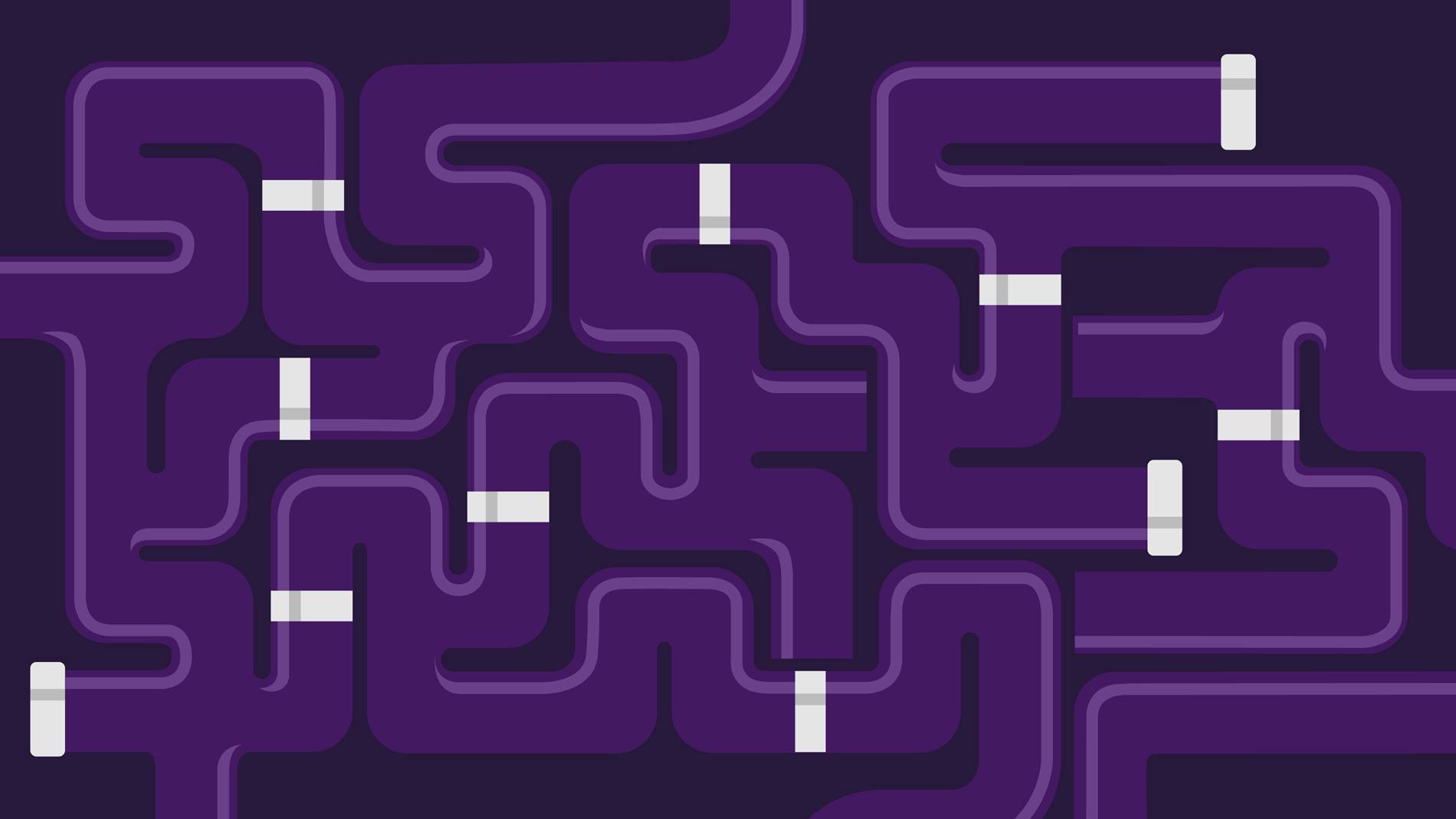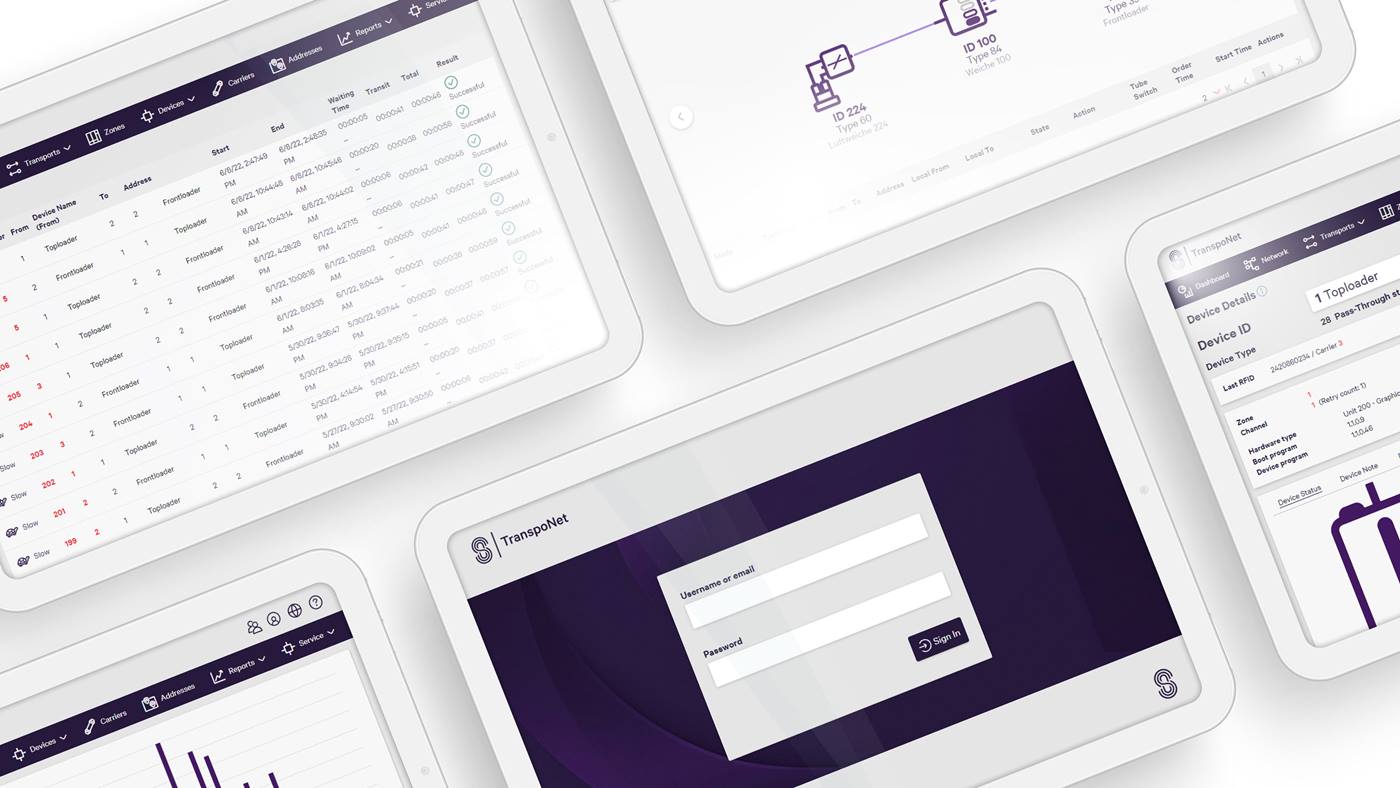Reading Time: 6 min.
We provide insights into the world of pneumatic tube transport and its components, summarizing the most important terms to help you plan a pneumatic tube system (PTS) for healthcare facilities, especially hospitals, whether you want to modernize an existing system or are starting from scratch.
The pneumatic technology that automatically propels goods across several floors or neighboring buildings has been in use since the mid 19th century. The different departments are connected by lines – like a subway network. Even though transportation by air pressure and suction isn’t the latest technology, the tube system has evolved over the years.
What pneumatic tube transport means for us
- Our PTS for hospitals is called TranspoNet.
- The portfolio includes 10 different types of stations.
- 4 different carriers can pass through the pneumatic system.
- The nominal width is usually either 110 or 160 mm.
- Transparent, white, gray, halogen-free, stainless-steel or blue high-density polyethylene – different colors and material of the tubes serve different purposes.
- User-friendly web-based software: Disruptions can easily be analyzed and created independent of device and location.
- Reliable tracking: The software solution Delivery Manager further optimizes your hospital logistics.
We prepared an overview of the most important terms to best prepare you for planning a pneumatic tube system– including helpful tips and tricks.
Sending and receiving: Different types of stations
Ensuring safe sending and receiving of goods: Whether it’s a sending station, a receiving station or a combination of both, there’s the right one for every area of application in a hospital. Laboratories usually work most efficiently with separate sending and receiving stations to manage the high transport volume of, for example, samples.
Through stations and end stations can be approached from above or below, but what distinguishes them? The through station can be compared to an Intercity train that does not stop at all locations, because the capsule passes through it without stopping. It is therefore particularly suitable for low transport volumes, as the through station generates short distances within a building. At the end station, on the other hand, the container leaves the PTS network and may have to be removed.
Right carrier – safe pneumatic tube transport
Whether blood reserves, laboratory samples, medications, supplies or documents – a special shipping container is required for transportation. Up to 1.5 kg can be shipped, depending on the size of the system. However, what is being shipped is also important. Medical goods often require additional secondary packaging or special transport carriers with a fixation for blood specimens tubes to ensure safe transportation without damage. The advantages of this fixation:
- Ergonomic handling
- Non-disposable product
- No additional storage of packaging materials
- Allows the use of an automatic loading station
Choosing the right carrier is therefore crucial for safely transporting samples through the tube system in the hospital.
From air switch to side channel blower: what’s in a PTS line
A PTS line consists of:
- Air switch: The air switch controls the airflow direction between pressure and suction to allow transport to go to different destinations rather than just one direction.
- Carrier damper: The canister is slowed down and the direction is changed by entering the carrier damper while a valve redirects the incoming air (bypass). Once the capsule is stopped, the valve diverts the air towards the carrier and pushes it back into the system.
- Side channel blower: The side channel blower generates the air flow from the existing ambient air.
What else?
- one or several tubes,
- one or several diverters,
- at least two stations, and
- the PTS software.
Keep in mind: For medium capacity, you shouldn’t be planning more than 10 stations per line to avoid compromising on efficiency. If you’d connect 20 with just one single line, you couldn’t use the other stations until transport is completed in this line. Exceptions are possible, of course – we are happy to advise you.
Interzone tube, direct line or PowerLine?
Usually, you differentiate between interzone tubes and direct lines. Direct lines can only transport in one direction. The standard interzone tube does both directions but moves only one carrier at a time. The airstream cannot be controlled and would make the carriers collide.
Complex buildings, long distances across several levels or buildings, crossing lines. It’s time for PowerLine. This line transports more than one carrier at a time, but only in one dedicated direction. Always plan a way back for this high-performance line.
Did you know?
- PowerLine is usually set up between two transfer units or between a transfer unit and a station in the hospital. It can connect several buildings.
- 75 – 85 % of all deliveries are sent to the laboratory: perfect for PowerLine
- Because of the high volume of transport, it’s also commonly referred to as a ‘highway’ in hospitals.
Connecting the lines for a seamless pneumatic tube network
To create an efficient tube transport system, all lines should be connected. Transfer units transfer medical goods from one line to another. These transfer points are the central junction of a PTS because they connect the lines.
A central location for the transfer unit is crucial. It must be easily accessible to facilitate maintenance for technicians. The basement, technical areas/levels or the attic are suitable places. The location should also enable short distances to reduce transport times and costs.
The size of the transfer unit depends on the number of lines you aim to connect. And you also must take the radius of the tubes and the size of the components into account. It always depends on the system size, but a ceiling height of 3,2 m is the minimum.
Which transfer unit is the right one?
If you want to connect up to 3 lines, the diverter transfer unit is a good one to choose. If it’s more than 3 lines or an expansion of a system, the compact transfer unit fits best. It’s modular and, as the name indicates, compact to save space. It enables fast transport for up to 16 lines per unit.
Clean air for a clean pneumatic tube: HEPA filters
Dirt and dust are inevitable, but HEPA filters help to keep your system clean. Especially in a clinical environment, this should be considered standard. The filters are located at both ends of the line, where the air is sucked in. It’s important to install them correctly to filter both directions properly.
Our advice: An additional pre-filter prevents gross contamination and increases service life.
Track and trace
RFID chips inside the carriers enable tracking that is monitored with PTS software. The dashboard is individually adjustable and gives a quick and easy overview of the system; reports can be generated easily. Even multiple users can work in the system to gain maximum efficiency.
Can I implement a pneumatic tube into an existing hospital building?
Yes, about 75 % of pneumatic tubes are planned for existing buildings. Besides the general requirements, you must keep the following two things in mind:
- Location and size of the room for the transfer unit
- Tube routing and location of switches
The size of the room generally depends on the size of the components and the tube bends – the radius is 800 mm. If you decide on a compact transfer unit with 4 lines, the room must be at least 7x4x3.2 m (l/w/h). The size varies for diverter transfer units.
For existing buildings, we generally recommend that the transfer unit is planned somewhere easily accessible. Diverters and switches in patient rooms, exam rooms or near elevators should be avoided to make maintenance easy.
Conclusion: Initial planning gets the most out of your pneumatic tube.
Did this deep dive into the world of tubes and pipes help you with planning, retrofitting or extending your system? Our TranspoNet offers a holistic portfolio of different types of stations and carriers, the possibility to analyze malfunctions easily, and the generation of reports and stats. The right carrier and the use of PowerLine are decisive factors to make the most of your system.
We at Swisslog Healthcare support you with your individual pneumatic tube planning. Look at our Designer Package or contact us for a personal exchange.








